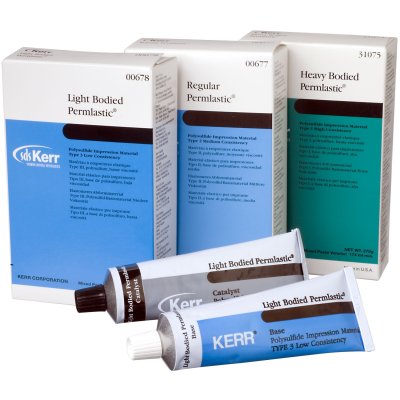 |
| Permlastic is a polysulfide, condensation-cured, elastomeric impression material in three viscosities |
Composition:
The polysulfide materials are supplied as two pastes, with one tube labelled catalyst or accelerator and the other marked as base.
Classification:
Depending on how easily they flow under load, they are classified as-
2. Medium Viscosity
3. Heavy Viscosity or Putty
Low Viscosity-Light Bodied
They are available as syringe material. It is used in combination with a tray material for making the impressions of prepared abutments and also for denture impressions in combination with a custom-made tray.
It is the freest flowing of the materials. It is excellent for inlay and fixed bridge impressions. Light-Bodied polysulfide material is a syringe material that is usually used with Heavy-Bodied material. Light Body bonds completely with both Regular and Heavy Bodies, resulting in impressions with great accuracy and fine definition.
Impression material is used alone. Regular bodied is recommended for partial- or full denture impressions because it has a high degree of flow that will register the finest detail. While usually used in single-mix, it can be used with Light-Bodied material for crown and bridge impressions. It will not tear when being removed from undercuts.
High viscosity-Heavy Bodied
Heavy-Bodied material is applied whenever a stiffer material is indicated. The heavy body consistency results in optimum compression of the Light-Bodied material in a double-mix, copper-band impression.
Its base material consists of about 80% low molecular weight organic polymer and contains reactive mercaptan groups, and 20% reinforcing agents, such as titanium dioxide, zinc sulphate, copper carbonate, or silica.
Catalyst is carried by inert oil such as dibutyl or dioctyl phthalate. The most common catalyst is lead dioxide with or without manganese dioxide. Another catalyst system is copper hydroxide.
Manipulation:
Two-paste type:
The procedure of extruding the accelerator on top of the base is not recommended because delays may occur before mixing, and a reaction starts at the interface and may result in a non-homogenous mix.
A tapered, stiff bladed spatula is recommended. The accelerator is mixed with the base for 5 to 10 seconds in a circular motion with the end of the spatula.
The blade of the spatula is wiped on the pad and then with a paper towel; this procedure makes it easier to obtain a mix free from streaks. The mixing is continued with a wide sweeping motion until the mix is free from streaks and uniform in colour. The mixing should be accomplished in about 45 seconds.
If the material is a medium or high viscosity material, it is placed in a tray. The tray has been constructed to provide a uniform space of about 2 mm for the impression material.
Custom trays of acrylic generally are used, and the inside of the tray is painted with rubber adhesive cement. The solvent from the adhesive layer is then allowed to evaporate; otherwise, the Polysulphide material may separate from the tray during removal from the mouth. Occasionally, holes are made through the tray to provide mechanical retention of the impression material.
If low viscosity-high viscosity technic is used, the mixed polysulfide is loaded into a syringe and is injected into the impression area (gingival sulcus and over the prepared tooth surface). Then the tray containing the high-viscosity material is placed over the low-viscosity material and is seated slowly and steadily. The low-and high-viscosity materials set together to give a single impression. The low-viscosity material records the critical surfaces and is supported by the high-viscosity material in the tray. Impressions also may be accomplished with a single mix of the medium-viscosity material.
If tearing of the impression occurs, the second time the impression is taken it should be left in the mouth several minutes longer to obtain a higher tear strength. After the removal of the impression, it is checked for completeness and details, is cleaned thoroughly by rinsing with the tap water, disinfected with a suitable disinfectant and rinsed again with water. The excess water is shaken off and any residual moisture is removed by a gentle stream of air.
Preparation of die or model should not be delayed because dimensional change from continued reaction goes on for several hours.
Image source: Internet